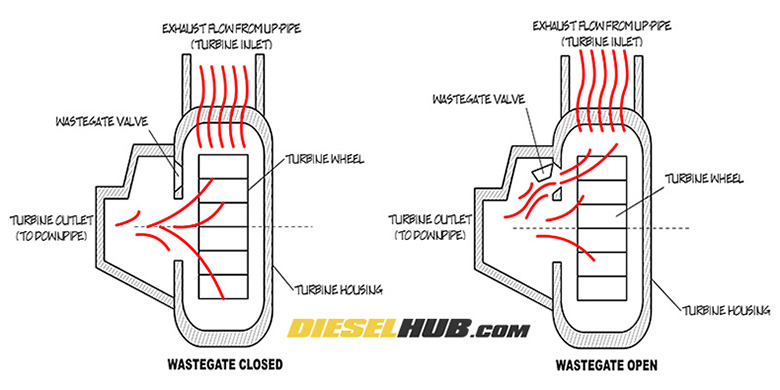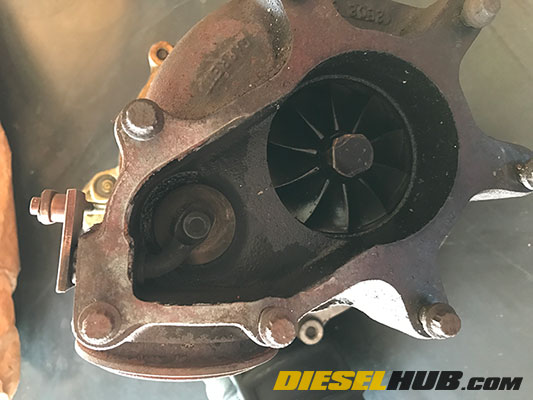What is a Wastegate
How a Wastegate Works
A wastegate is a device integrated into a turbocharger that controls the maximum allowable boost pressure. The concept of a wastegate is somewhat simple if you recall that turbocharger boost is directly related to the mass flowrate, pressure, and temperature of exhaust gases as they pass through the turbine housing of the turbocharger. It is at this stage that the heat energy (potential energy) of the engine exhaust is translated into mechanical energy by the turbine wheel. If exhaust flow is diverted such that it does not flow across the turbine wheel of a turbocharger, than its potential energy is not converted by the turbine. Simply put, reducing exhaust flow across the turbine reduces and/or controls boost pressure. In a nutshell, a wastegate simply diverts exhaust gas flow around the turbine wheel and straight into the exhaust downpipe once a predetermined manifold pressure (boost pressure) is reached.

Exhaust flow diagram of an internal wastegate with the wastegate valve in the closed and open position.
Note that the red lines indicate the concentration of exhaust flow through the turbine housing and across the turbine wheel.
Types of Wastegates
There are two types of wastegates; internal and external. An internal wastegate is integrated into the turbine housing assembly. An external wastegate is installed in the exhaust up-pipe between the exhaust manifold and turbine housing inlet. In either instances, an actuator is required to operate the wastegate valve. When the valve is opened, exhaust flow is diverted away from its normal path across the turbine wheel and instead exits directly into the exhaust downpipe.
Wastegate Control Methods
One of the simplest methods of controlling a wastegate valve is by means of intake manifold pressure (manifold absolute pressure or MAP). A line or hose connects the intake manifold to a wastegate actuator, which is essentially a mechanical diaphragm and spring device. The spring inside the wastegate actuator holds the valve in the closed position. As intake manifold pressure (boost pressure) so does the pressure in the wastegate actuator, applying a force to the diaphragm. When the force exerted on the diaphragm exceeds the force of the spring, the wastegate valve begins to open. As boost pressure drops, the spring closes the wastegate.
Another method popular on electronically controlled engines uses an electric solenoid to control the position of the wastegate. A 6.5L GM diesel, for example, uses vacuum from the engine driven vacuum pump to control the wastegate. When full vacuum is applied to the wastegate actuator, it closes the valve in the turbine housing and no exhaust gases bypass the turbine wheel. When no vacuum is supplied, exhaust gases are allowed to bypass the turbine wheel and exit directly into the downpipe. The electronically controlled actuator adjusts perpetually to maintain peak boost pressure and prevent the turbocharger from supplying excessive manifold pressure and/or overspeeding under load.
A more modern implementation of wastegate control is by means of an electric actuator; this is becoming increasingly popular on turbocharged engines. Rather than rely on a manifold pressure or a vacuum source, these wastegates feature an electric solenoid that is controlled directly by the PCM and adjusts the position of the wastegate valve.

Wastegate valve in the turbine housing outlet of a Garrett GTP38 turbocharger
(1999.5 - 2003 7.3L Power Stroke)
Wastegates and Variable Geometry Turbochargers (VGT)
Traditionally (with exceptions), a variable geometry turbocharger (VGT) does not require the use of a wastegate as boost is controlled perpetually by the position of the vanes in the turbine housing. Recall that a VGT physically adjusts the effective size of the turbine housing by increasing or decreasing the pressures of exhaust gases acting on the turbine wheel. Rather than divert exhaust gases around the turbine wheel a VGT simply opens the vanes, simulating a similar effect as a wastegate. As the vanes close, exhaust energy acting on the turbine wheel increases. This range of motion is used to provide desirable turbocharger response while controlling peak boost pressure and performance characteristics under all conditions.
Blow Off Valve vs Wastegate
An alternative to a wastegate is a blow-off valve. A blow-off valve is a mechanical valve mounted between the turbocharger compressor outlet and intake manifold (can be mounted anywhere in the intake system on the pressure side of the turbo). These are typically adjustable and will “blow off” excessive manifold pressure once turbo boost reaches the calibrated setting. Excessive boost pressure is released to the atmosphere. Once the manifold pressure drops below the max setting, the valve defaults to the closed position. Unlike a wastegate, a blow-off valve is traditionally used as a failsafe device and not a means of consistently controlling manifold pressure. A blow-off valve can be used on an engine with a wastegated turbocharger as an added means of protection against excessive manifold pressure.
Wastegate Modifications for Performance Increases
In some instances a wastegate system can be modified in order to produce higher peak manifold pressure (boost) by altering the relationship between wastegate valve position and boost pressure. Simply put, holding the wastegate closed longer allows the turbo to build greater boost. One example of such a modification is the popular "J hook" upgrade for the 2001 to 2002 model year 24 valve Cummins. The aftermarket product features a stiffer spring than the factory linkage, thus increasing the boost pressure required to open the wastegate. In other instances, the wastegate actuator hose can be modified to bleed off pressure such that more manifold pressure will be required to operate the wastegate valve. Such modifications are inexpensive and relatively effective with an obvious point of diminishing return. One must keep in mind that a combination of air and fuel creates power, thus the most noticeable gains will occur when fuel system upgrades have been performed to increase the fueling characteristics of the engine.